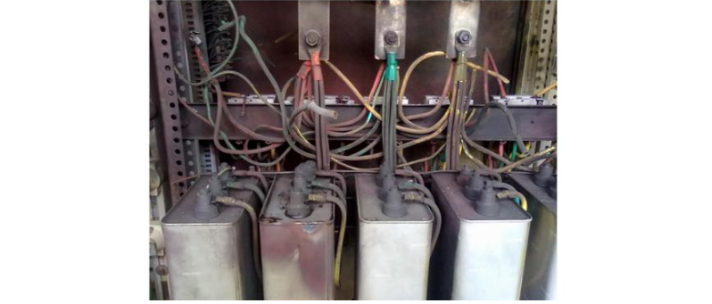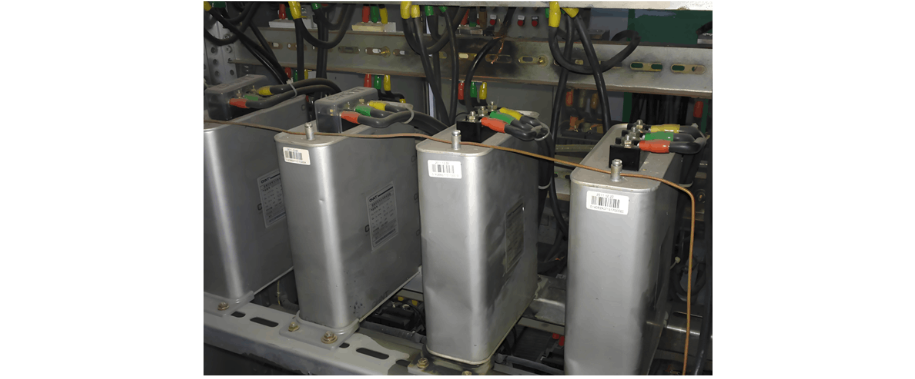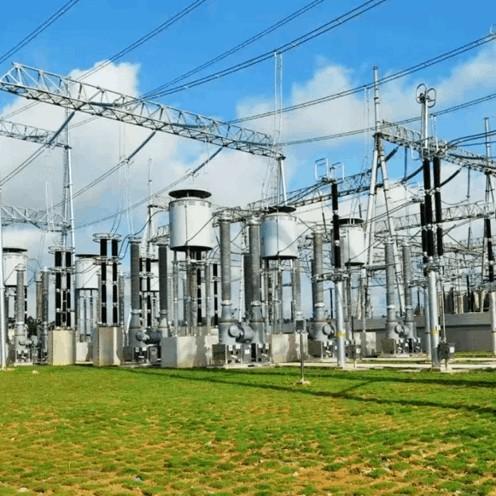Pahimongod ug Pautan sa Operasyon ug Maintenance alang sa mga Power Capacitors
Ang mga power capacitors mao ang mga static reactive power compensation devices nga gamiton sa pag-supply og reactive power sa mga electrical systems ug pag-improve sa power factor. Tungod sa pagsiugda sa lokal nga reactive power compensation, sila molambo sa pagbawas sa transmission line current, pagminimize sa line power losses ug voltage drops, ug makatabang nang dako sa pag-improve sa power quality ug mas taas nga paggamit sa equipment.
Ang sumusunod mao ang key aspects sa operasyon ug maintenance sa mga power capacitor isip reference.
1. Proteksyon sa mga Power Capacitors
(1) Kinahanglan nga ang maayo nga mga protektibong hakbang mahimong gi-apply sa mga capacitor banks. Kini mahimo nga maglakip og balanced o differential relay protection, o instantaneous overcurrent relay protection. Para sa mga capacitors nga may rating sa 3.15 kV ug uban pa, girekomenda nga i-install ang individual fuses sa bawg kapasador. Ang rated current sa fuse kinahanglan nga mapili batas sa fuse characteristics ug inrush current sa panahon sa energization, kasagaran 1.5 ka beses sa rated current sa capacitor, aron maprevent ang oil tank explosions.

(2) Sumala sa ubos, ang additional nga mga protektibong hakbang mahimong gi-apply kon kinahanglan:
Kon ang voltage rise adunay kausaban ug nagpatuloy, kinahanglan nga ang mga hakbang mahimong gi-apply aron mapasuportahan nga ang voltage wala mogawas sa 1.1 ka beses sa rated value.
Gamiton ang maayo nga automatic circuit breakers aron maprotektahan sa overcurrent, limitahan ang current sa wala mousab sa 1.3 ka beses sa rated current.
Kon ang capacitors gikonekta sa overhead lines, ang suitable nga surge arresters mahimong gamiton aron maprotektahan sa atmospheric overvoltages.
Sa high-voltage systems diin ang short-circuit current mogawas sa 20 A ug ang standard nga protective devices o fuses wala makapugos nga clear sa ground faults, ang single-phase ground fault protection mahimong ipatuman.
(3) Ang maayo nga pagpili sa mga proteksyon schemes mahimong critikal sa safe ug reliable nga operasyon sa capacitor. Bisag unsa nga metodo ang gamiton, ang proteksyon system kinahanglan nga mosatisfy sa sumusunod nga requirements:
Sufficient sensitivity aron mapasuportahan ang reliable nga operasyon kon adunay internal faults sa bisan unsang single capacitor o failure sa individual elements.
Ability sa selective removal sa mga faulty capacitors, o allow easy identification sa damaged units human sa complete de-energization.
Wala magfalse tripping sa panahon sa switching operations o system faults sama sa ground faults.
Easy to install, adjust, test, ug maintain.
Low power consumption ug operating cost.
(4) Ang automatic reclosing wala mahimong ig-install sa capacitor banks. Ania ang undervoltage release trip device ang mahimong gamiton. Kon ang capacitors nagkinahanglan og panahon aron mobasa. Kon ang reclose mahimo sa agad human sa tripping, ang residual charge nga may polarity opposite sa re-energizing voltage mahimong mobati, resulta sa extremely high inrush currents nga mahimong makaingon sa casing bulging, oil spraying, o even explosion.
2. Energizing ug De-energizing sa mga Power Capacitors
(1) Human sa energizing sa capacitor bank, gamiton ang megohmmeter aron sukadon ang discharge circuit.
(2) Ang sumusunod nga considerations applicable sa panahon sa switching sa capacitor banks:
Ang capacitor banks wala mahimong giconnect sa grid kon ang bus voltage mogawas sa 1.1 ka beses sa rated voltage.
Human sa disconnection sa grid, ang capacitor bank wala mahimong mure-energized sa loob sa 1 minute, bisan sa automatic repeated switching applications.
Ang circuit breakers nga gamiton sa switching wala mahimong mogenerate og dangerous overvoltages. Ang breaker's rated current wala mousab sa 1.3 ka beses sa capacitor bank's rated current.
3. Discharge sa mga Power Capacitors
(1) Human sa pag-disconnect sa grid, ang capacitors kinahanglan nga automatic discharge. Ang terminal voltage wala mogawas sa 65 V sa loob sa 30 seconds human sa disconnection, bisan unsa ang rated voltage.
(2) Aron masiguro ang safety, ang automatic discharge devices kinahanglan nga gi-install sa load side sa capacitor circuit breaker ug directly in parallel sa capacitor (wala na siya mag-include og switches, isolators, o fuses). Ang capacitor banks nga equipped sa non-dedicated discharge devices—sama sa voltage transformers (para sa high-voltage capacitors) o incandescent lamps (para sa low-voltage capacitors), o diretso nga giconnect sa motors—wala na kinahanglan og additional discharge devices. Kon ang mga lamps ang gamiton, ang service life mahimong mapalitog sa pag-increase sa number sa lamps in series.
(3) Bisan unsa ang automatic discharge, ang grounded, insulated metal rod kinahanglan nga gamiton aron short-circuit ang capacitor terminals para sa manual discharge bago matouch ang anumang conductive parts sa disconnected capacitor.
4. Maintenance ug Care Sa Panahon sa Operasyon
(1) Ang capacitor banks kinahanglan nga gimonitor sa trained personnel, ug ang operational records kinahanglan nga maintained.
(2) Ang visual inspections sa operating capacitor banks kinahanglan nga gi-conduct daily sumala sa regulations. Kon ang tank bulging observed, ang unit kinahanglan nga gikuha sa serbisyo sa agad aron maprevent ang failure.
(3) Ang phase current sa capacitor bank mahimong gi-monitor gamit ang ammeters.
(4) Ang capacitors wala mahimong muenegize kon ang ambient temperature below −40 °C. Sa panahon sa operasyon, ang average temperature wala mogawas sa +40 °C sa loob sa 1 hour, +30 °C sa loob sa 2 hours, o +20 °C annually. Kon ang limits mogawas, ang artificial cooling (e.g., fans) mahimong gamiton o ang capacitor bank disconnected sa grid.
(5) Ang temperature checks sa installation site ug sa hottest spot sa capacitor casing mahimong gi-perform gamit ang mercury thermometers o equivalent, ug ang records kinahanglan nga kept (especialmenteha sa summer).
(6) Ang operating voltage wala mogawas sa 1.1 ka beses sa rated voltage; ang operating current wala mogawas sa 1.3 ka beses sa rated current.
(7) Ang connecting sa capacitors mahimong mogawas sa system voltage, espetialmenteha sa light load. Sa mga kasagaran, bahin o tanang capacitor bank kinahanglan nga gdisconnect.
(8) Ang bushings ug support insulators kinahanglan nga clean, undamaged, ug free sa discharge marks. Ang capacitor casing kinahanglan nga clean, undeformed, ug leak-free. Wala na siya mag-accumulate og dust o debris sa capacitor o sa iyang support frame.
(9) Ang tanang connections sa capacitor circuit (busbars, grounding wires, circuit breakers, fuses, switches, etc.) kinahanglan nga gi-inspect sa reliability. Bisan unsa ka loose screw o poor contact mahimong makaingon sa premature capacitor failure o system-wide incidents.
(10) Kon ang dielectric withstand test required human sa period sa operasyon, kinahanglan nga gi-conduct sa specified test voltage.
(11) Ang inspection sa capacitance values ug fuses kinahanglan nga gi-perform at least once per month. Ang loss tangent (tanδ) sa capacitors kinahanglan nga gi-measure 2–3 times per year under rated or near-rated voltage aron assess insulation condition.
(12) Kon ang capacitor bank trips tungod sa relay operation, wala mahimong mure-energized hangtud ang cause identified.
(13) Kon ang oil leakage natukdan sa panahon sa operasyon o transport, mahimong repair sa brazing sa tin-lead solder.

5. Switching (Isolation) Operation Precautions
(1) Sa normal conditions, sa panahon sa complete substation shutdown, ang capacitor bank circuit breaker kinahanglan nga unang gi-open, sumala sa outgoing line breakers. Sa panahon sa re-energization, ang sequence mahimong reverse.
(2) Sa event sa complete power outage, ang capacitor bank circuit breaker kinahanglan nga gi-open.
(3) Human sa capacitor bank trips, ang forced re-energization prohibited. Kon ang protective fuse blows, ang fuse wala mahimong replaced ug mure-energized hangtud ang cause determined.
(4) Ang capacitors wala mahimong muenegize while charged. Human sa disconnection, ang re-closing kinahanglan nga delayed sa loob sa at least 3 minutes.
6. Fault Handling Sa Panahon sa Operasyon
(1) Kon ang oil spraying, explosion, o fire natukdan, immediate disconnect ang power supply ug extinguish ang fire gamit ang sand o dry-type fire extinguisher. Ang mga kasagaran mao ang resulta sa internal/external overvoltages o severe internal faults. Aron maprevent ang recurrence, sigurado nga ang fuse ratings correct, avoid ang forced re-energization human sa tripping, ug wala maggamit og auto-reclosing.
(2) Kon ang circuit breaker trips pero ang branch fuse intact, discharge ang capacitor sa 3 minutes, then inspect ang breaker, current transformer, power cable, ug external condition sa capacitor. Kon wala natukdan ang abnormalities, ang fault mahimong due sa external disturbances o voltage fluctuations. Sumala sa confirmation, ang test re-energization mahimong attempted. Otherwise, conduct a full energized test sa protection system. Kon ang cause wala natukdan, dismantle ang bank ug test each capacitor individually. Wala mahimong mure-energization hangtud ang cause found.
(3) Kon ang fuse blows, report sa duty dispatcher ug obtain approval before opening ang capacitor circuit breaker. Human sa de-energizing ug discharging, perform ang external inspection (e.g., bushing flashover, casing deformation, oil leakage, grounding faults). Then measure inter-terminal ug ground insulation resistance gamit ang megohmmeter. Kon wala natukdan ang fault, replace ang fuse ug resume operation. Kon ang fuse blows again human sa re-energization, isolate ang faulty capacitor ug restore service sa remainder.
7. Safety Precautions Sa Panahon sa Handling Faulty Capacitors
Bisan unsa ang handling sa faulty capacitor, disconnect ang iyang circuit breaker, open ang disconnect switches sa both sides, ug discharge ang bank through ang discharge resistor (e.g., discharge transformer o VT). Tungod sa possible residual charge, ang manual discharge wala mahimong performed. Unang secure ang grounding end sa grounding rod, then repeatedly discharge ang capacitor terminals hangtud ang wala na sparks o sounds. Finally, secure ang ground connection.
Ang faulty capacitors mahimong adunay poor internal connections, open circuits, o blown fuses, leaving residual charge. Therefore, ang maintenance personnel kinahanglan nga mag-wear insulating gloves ug short-circuit ang two terminals sa faulty capacitor gamit ang shorting wire bago matouch.
Para sa capacitor banks nga may double-star connections, ang neutral line, ug para sa series-connected capacitor strings, ang individual discharge wala mahimong performed.
Sa among substation equipment, ang power capacitors relatively vulnerable tungod sa weaker insulation, higher internal heat generation, poor heat dissipation, higher internal failure rates, ug combustible internal materials, making them prone sa fire. Therefore, favorable low-temperature ug well-ventilated operating conditions kinahanglan nga provided basta posible.
8. Repair sa mga Power Capacitors
(1) Ang sumusunod nga faults mahimong repaired on-site:
Ang oil leakage gikan sa casing mahimong repaired sa soldering sa tin-lead alloy.
Ang oil leakage sa bushing welds mahimong repaired sa soldering, pero care must be taken sa pag-avoid sa excessive heat nga mahimong damage sa silver plating.
(2) Ang failures sama sa ground insulation breakdown, significantly increased loss tangent, severe casing bulging, o open circuits require repair sa specialized capacitor service facilities equipped sa proper tools ug testing equipment.
























